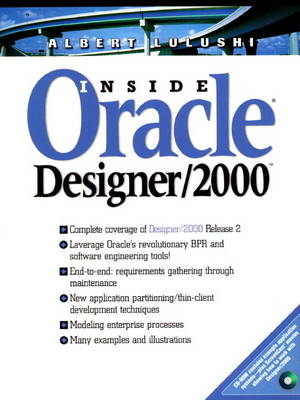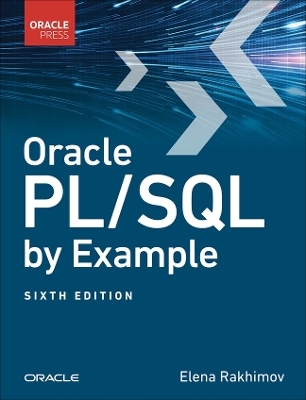
Inside Oracle Designer/2000
Prentice Hall (Verlag)
978-0-13-849753-8 (ISBN)
- Titel ist leider vergriffen;
keine Neuauflage - Artikel merken
84975-2 Master Oracle's Designer/2000 Release 2 with this complete, up-to-date reference and tutorial. Inside Oracle Designer/2000 walks you through every step of business process modeling, software engineering, and implementation with Oracle's breakthrough Designer/2000 suite. You'll start by developing a simple application system that covers all the Designer/2000 and RAD basics you'll need to know, including: *Modeling entities and relationships *Creating function hierarchies *Transforming requirements in database objects and software modules *Maintaining object properties *Generating database objects and software modules Inside Oracle Designer/2000 presents detailed coverage of make-or-break technical issues such as application partitioning and thin-client development. You'll learn to use every component of Designer/2000, design database systems, generate software modules of different flavors, and maintain the systems you create.You'll also get practical guidance with the business side of process reengineering: *Modeling the enterprise's strategic direction and information infrastructure *Preparing for reengineering and continuous process improvement *Creating process models that successfully implement business rules You'll find many detailed examples-including the hands-on construction of OLTP and data warehouse systems.
One step at a time, you'll gradually build your knowledge and confidence with these sophisticated tools. An extraordinary collection of Oracle Designer/2000 resources on CD-ROM, including...Several Oracle Designer/2000 application systems, full of ideas for your own application design...software modules that show exactly what you can achieve with Designer/2000...even ScreenCam "movies" for every important Designer/2000 activity-so you won"t just read about it, you'll see it done! Oracle's Designer/2000 transforms database developers into enterprise reengineers. Now's the time to get out front with these revolutionary tools. Start today, with Inside Oracle Designer/2000!
I. INTRODUCTION TO DESIGNER/2000.
1. Analyzing the Requirements.
Creating a New Application System. Data Modeling. Function Modeling. Summary.
2. Designing and Generating Database Objects.
Database Design Transformer. Designing the Physical Database. Enhancing the Data Design. Generating Database Objects. Summary.
3. Designing and Generating Software Modules.
Generating the Initial Module Design. Enhancing the Design of User Interface Modules. Expanding Modules with Unbound and Action Items. Designing and Programming PL/SQL Modules. Generating the Application Modules. What Next? Summary.
4. Understanding the Designer/2000 Architecture.
Overview of Designer/2000. Designer/2000 Repository Model. Repository Administration Utility. Extending and Customizing the Repository. Summary.
5. Maintaining Application Systems.
Creating and Maintaining Application Systems. Creating and Maintaining Application Objects. User-Defined Object Sets. Summary.
6. Object Navigators in Designer/2000.
Components of Object Navigators. Working with Navigator Windows 188 Working with Property Palettes 200 Summary 206
7. Diagrammers in Designer/2000.
Diagrams and Diagrammers. Components of Diagrammers. Working with Diagrams. Working with Objects in Diagrams. Customizing Diagrammer Preferences. Enhancing Diagrams with OLE Technology. The Matrix Diagrammer. Summary.
II. STRATEGIC PLANNING AND BUSINESS AREA ANALYSIS.
8. Modeling the Business Direction of the Enterprise.
Setting the Scene. The Enterprise Model Business Units Goals and Objectives. Problems. Critical Success Factors. Key Performance Indicators. Assumptions. Summary.
9. The Enterprise Functional and Information Models.
Defining the Functional Model of the Enterprise. Defining the Information Model of the Enterprise. Modeling Mutual Exclusivity of Data and Relationships. Associating Entities with Other Repository Objects. Summary.
10. Modeling Business Processes.
What Are Business Processes? Why Model Business Processes? Creating the Process Model of the Enterprise. Creating Processes in the Process Modeller. Modeling the Customer. Analyzing the Business Areas of the Enterprise. Summary.
11. Business Area Analysis.
Defining Business Area Processes. Analyzing Processes in Detail. Animation and Multimedia. Synthesizing the Business Area. Summary.
12. Business Process Reengineering.
Symptoms of Aching Processes. Prescriptions for Aching Processes. Preparing for Reengineering Business Processes. Reengineering. Reengineering TASC. Summary.
III. SYSTEMS REQUIREMENTS DEFINITION AND ANALYSIS.
13. Requirements Analysis.
Business Requirements and System Requirements. Using Designer/2000 in Requirements Analysis. Building the High-Level System Model. Documenting the High-Level System Design. Defining the User Interface Requirements. Summary.
14. Data Modeling.
Techniques and Approaches to Data Modeling. Entity Modeling. Domains in Designer/2000. Relationship Modeling. Normalization and Denormalization of Data. Data Modeling for Data Warehouses. Maintaining Multiple Data Models. Summary.
15. Business Rules Modeling.
Function Data Usages. Business Rules. Data Definition Rules. Data Manipulation Rules. Access Privilege Rules. Summary.
16. Quality Assurance of the System Requirements.
Organizing the Diagrams. Verifying and Reporting the Data Model. Verifying and Reporting the Functional Model. Summary
IV. SYSTEM DESIGN.
17. Creating the Initial Logical Database Design.
Database Design Transformer Interface. Creating the Logical Database Design. Controlling the Settings of the Transformer. How the Transformer Creates the Database Design. Maintaining the Logical Database Design. Mapping Supertype and Subtype Entities to Tables. Summary.
18. Enhancing the Logical Database Design.
Maintaining Data Diagrams. Maintaining Tables. Providing for Data Auditing and Journaling. Creating and Maintaining Indexes. Maintaining Views. Maintaining Snapshots. Creating and Maintaining Sequences. Using the Database Object Guide. Summary.
19. Implementing the Physical Database Design.
Documenting the System's Foundations. Defining Database Components. Defining Database Users. Implementing Logical Design Objects in a Database Schema. Using the Database Administrator Guide. Preserving the Physical Database Design Flexibility. Summary.
20. Implementing Business Rules with Constraints.
Business Rules Reviewed. Implementing Business Rules. Creating and Maintaining Constraints. Primary and Unique Key Constraints. Foreign Key Constraint Properties. Check Constraint Properties. Deriving Column Values in Front-End Applications. Summary.
21. Creating the Application Design.
The Purpose of the Application Design Transformer. Generating Presentation Layer Modules. Accepting and Rejecting Candidate Modules. Generating Menu Modules. Summary.
22. Maintaining Modules in the Design Editor.
Modules in Designer/2000. Structure of Modules. Working with Modules. Creating and Maintaining Module Elements. Module Wizards. Reusable Components. Summary.
23. PL/SQL in Designer/2000.
Overview of PL/SQL. Procedural Constructs of PL/SQL. Data Types and Variables. Cursors in PL/SQL. PL/SQL Program Units. Exception Handling. Summary.
24. Maintaining PL/SQL Objects in Designer/2000.
Maintaining Server Side PL/SQL Objects. Understanding and Maintaining the Server API. Maintaining Application Logic Objects. The Logic Editor. Working with the Logic Editor. Summary.
V. SOFTWARE GENERATION AND DEVELOPMENT.
25. Generating Database Server Objects.
Preparing for Generation. Designer/2000 Server Generator. Post-Generation Tasks. Different Scenarios of Using the Server Generator. Recovering the Design of Databases. Summary
26. Generating Front-End Software Modules.
Repository-Based Software Development. Maintaining Preferences. Object Class Libraries. Generator Templates. Designer/2000 Front-End Generators. Summary.
27. Introduction to Generating Developer/2000 Forms Modules.
Preparing for Generation. Enforcing Application-wide GUI Standards. Implementing a Flexible Messaging Strategy. Generating Developer/2000 Forms Modules. Summary.
28. Advanced Developer/2000 Forms Generation.
Generating Forms with Multiple Table Usages. Item Lookups and Lists of Values. Adding GUI Controls to Modules. Adding Calendar Controls to Developer/2000 Forms Modules. Summary.
29. C++ Object Layer Generator.
The Purpose of the C++ Object Layer Generator. Preparing for C++ Generation. Using the C++ Object Layer Generator.. Understanding the Output of the C++ Object Layer Generator. Summary.
Index.
| Erscheint lt. Verlag | 9.1.1998 |
|---|---|
| Verlagsort | Upper Saddle River |
| Sprache | englisch |
| Gewicht | 1964 g |
| Themenwelt | Informatik ► Datenbanken ► Oracle |
| ISBN-10 | 0-13-849753-2 / 0138497532 |
| ISBN-13 | 978-0-13-849753-8 / 9780138497538 |
| Zustand | Neuware |
| Informationen gemäß Produktsicherheitsverordnung (GPSR) | |
| Haben Sie eine Frage zum Produkt? |
aus dem Bereich

